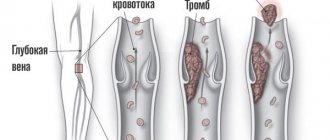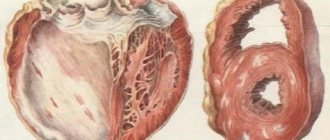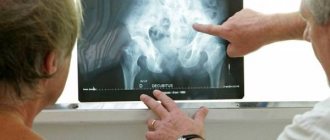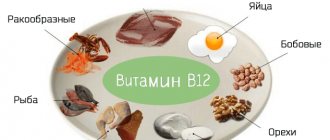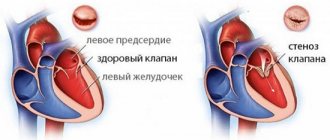Etiology
An atherosclerotic plaque is a pathological structure that forms on the wall of a vessel. Normally, cholesterol gives arteries elasticity, which ensures uniform and stable blood flow.
If the patient suffers from atherosclerosis, a disorder of cholesterol metabolism occurs, which is gradually deposited on the inner wall of the vessel. As a result, plaques are formed, which are the main symptom of the disease - they are capable of growing and blocking the lumen of the artery. Most often, atherosclerosis affects large vessels - the aorta, upper limbs and arteries of the head.
The main reasons for the formation of plaques in atherosclerosis:
- Compounded heredity - there is a genetic predisposition to atherosclerosis and plaque formation,
- Overweight – the likelihood of developing the disease increases in obese people,
- Dietary disorder – with increased consumption of animal fat, the level of cholesterol in the blood increases, which leads to its deposition on the walls of blood vessels and the formation of plaques,
- Endocrine disorders - increased concentrations of glucose in the blood and lack of insulin contribute to the development of atherosclerosis,
- Long-term smoking affects metabolism and the condition of the arteries, and also worsens the treatment of this pathology,
- Arterial hypertension - if not treated, high blood pressure negatively affects the walls of blood vessels, triggering the formation of cholesterol plaques,
- A sedentary lifestyle – lack of physical activity accelerates the destruction of blood vessels in atherosclerosis,
- Prolonged psycho-emotional stress – contributes to the development of hypertension or impaired fat metabolism,
- Occupational hazards - the negative impact of toxic substances at work can provoke vascular diseases, including atherosclerotic damage,
- Infections - some microbial agents damage not only blood cells, but also the intima of the arteries, provoking the development of pathology,
- Age – after 30 years of age, metabolism begins to slow down; if there is a tendency towards obesity, atherosclerosis develops. When a person does not adjust the menu and reduces foods containing animal fats in the diet, a cholesterol metabolism disorder occurs.
Interesting!
The listed reasons have a gradual effect on the body, contributing to the development of atherosclerosis. The resulting plaques do not immediately lead to the appearance of symptoms - the first signs may become apparent several years after the onset of the disease.
Prevention
Cholesterol deposits are recorded quite often and are a very common disease.
By following the recommendations, you can significantly reduce the risk of vascular damage from atherosclerotic plaques.
Main recommendations:
- Get rid of excess weight and obesity (if any);
- Normalize the state of the nervous system;
- Maintain a daily routine and a balance between work and proper sleep;
- Monitor blood pressure levels;
- Eat properly;
- Lead a more active and healthy lifestyle;
- Stop smoking and drinking alcohol.
Healthy lifestyle
The list of recommendations is not complicated, but will help to significantly reduce the risks of developing pathology.
How does pathology develop?
For atherosclerotic changes to occur, two main conditions are necessary: damage to the artery wall and a slowdown in blood flow. That is why the first lesions in atherosclerosis develop in places where blood vessels bend or divide.
Most substances circulating in the bloodstream do not stick together and do not settle on the vessel wall due to the action of special enzymes. When atherosclerosis develops, their activity decreases, which leads to the appearance of the first minimal deposits in areas where blood flow is slow or the vascular epithelium is damaged. Gradually the plaque increases in size and forms two layers:
- The internal or core is the main element in the structure of an atherosclerotic plaque. Represented by cholesterol, esters and immune cells - macrophages, separating the core from the outer shell,
- External – represented by elastin and collagen fibers. Elasticity depends on the percentage of these substances - if it is weak, the membrane ruptures, the core exits into the lumen of the artery. In this case, a serious complication may develop - blockage of the vessel and infarction of the brain or the muscular lining of the heart - the myocardium.
At the initial stages of atherosclerosis, plaques are loose and mobile - this condition is dangerous because it can provoke the tearing of part of it and blockage of a smaller caliber artery. Over time, calcium salts are deposited in the outer shell, connective tissue grows, and the plaque becomes hard. At this stage, the risk of its rupture is reduced, but persistent disturbances in blood flow are observed due to partial closure of the lumen of the vessel.
Stages of education
Pathology develops gradually, passing through several stages. First, the disease is triggered under the influence of causative factors, then the resulting pathological changes lead to an immune response, which strives to protect the body, but creates optimal conditions for the formation of cholesterol deposits.
Stages of atherosclerotic plaque formation:
- A yellow spot forms on the wall of the vessel, consisting of deposits of cholesterol and its compounds,
- The immune system is activated - protective blood cells - T-lymphocytes and monocytes - are concentrated along the periphery,
- The cells die and become part of the nucleus, the destruction of the vascular wall begins,
- Platelets are drawn to the affected area - this is the body’s protective reaction to damage,
- Enzymes that destroy the vascular wall are released into the bloodstream - this leads to active cell division in the affected area,
- The sediment grows and increases in size, collagen and elastin accumulate along the periphery. In this structure you can see the central part - the core and the outer shell - the tire,
- The atherosclerotic plaque thickens, creating an obstacle to blood flow, and the first signs of the disease develop.
At the final stage, the artery loses its elasticity. In advanced stages, damage to the outer shell occurs, ulcers and bleeding form, calcium salts are deposited in the tire, and its elasticity decreases.
Expert opinion!
Patients often ask whether atherosclerotic plaques resolve or not - much depends on the stage of the disease. The optimal time for conservative therapy is in the initial stages, since young clots respond well to treatment. At the calcification stage, it is almost impossible to dissolve atherosclerotic plaques.
Expert forecast
Further prognosis of the patient’s life depends on the location of the vessel blocking by an atherosclerotic plaque, and the degree of its blocking.
With minor overlaps, a proper diet and a balanced lifestyle are used, this normalizes cholesterol levels and removes atherosclerotic plaques. The outcome in this case is favorable.
In the case of moderate vascular occlusion, drug treatment is used in combination with proper nutrition and lifestyle. If all the doctor’s requirements are met and medications are taken in a timely manner, cholesterol is normalized and returns to normal.
If you do not take prescribed medications, or if they are not effective, as well as if you do not follow a diet and a healthy lifestyle, complications occur. Complications from atherosclerotic plaques are serious, and if the vessel is completely blocked by the plaque, hypoxia occurs in the organs to which the vessel led.
Gradual death of tissue occurs; in the absence of surgical intervention, serious consequences are possible (heart attack, stroke, gangrene, complete death of organs), which ultimately lead to death.
The presence of cholesterol deposits in the blood requires immediate treatment to prevent the progression of atherosclerosis.
If you notice symptoms or suspect atherosclerotic plaques, consult your doctor.
Do not self-medicate and be healthy!
Types of atherosclerotic plaques
The classification is based on the structure of atherosclerotic deposits - this division is relevant for the attending physician, because allows you to choose the optimal treatment method.
Types of atherosclerotic plaques:
- Stable – characterized by a dense consistency; the tire contains a large amount of collagen fibers or calcium salts. An important prognostic criterion is the slow growth of these forms, but poor dissolution ability. They can only be removed during surgery,
- Unstable atherosclerotic plaque - consists of fats and grows quickly. This form is more dangerous, since it can be complicated by rupture and release of the contents of the nucleus into the blood, causing an acute condition in the form of circulatory failure,
- Heterogeneous - the most malignant variant of the pathology, the plaque is loose, prone to rupture. Damage, growths and hemorrhages are observed on its surface.
When selecting treatment, the doctor must take into account the structure of the atherosclerotic clot - with the latter option, surgical intervention would be the most optimal.
Clinical picture
The accumulation of cholesterol on the inner lining of the arteries leads to a decrease in its lumen. If in a healthy person, during the work of the heart, the walls of blood vessels stretch and compensate for pressure drops, then in a patient with atherosclerosis this does not happen. The capacity of the artery gradually decreases - the amount of blood passed will not be enough to provide oxygen and nutrients to the organs and tissues located along its course. Symptoms of the disease largely depend on the location of the atherosclerotic plaque.
Aortic lesion
This is the largest artery, which originates from the left ventricle and is divided into two trunks - the thoracic and abdominal.
The thoracic region supplies blood to the upper half of the torso, arms, head and neck. Most symptoms develop due to insufficient blood supply to these sections:
- The appearance of pain in the chest, which can spread to the neck, shoulder blade or shoulder,
- If appropriate treatment is not carried out, symptoms of heart failure, shortness of breath, and the development of arterial hypertension with an increase in upper pressure readings occur.
Damage to the abdominal aorta is characterized by:
- Pain in the abdomen, in the area of the umbilical ring,
- Intestinal disorders
- Decreased function of the genital organs,
- Pain in the legs, lameness,
- Loss of sensation in the lower extremities, increased skin damage, development of bleeding and ulcers.
Damage to the blood vessels of the head
Often, against the background of a pronounced disorder in cholesterol metabolism, pathological changes can rise upward and affect the arteries of the head and neck. Atherosclerosis of this localization is characterized by:
- Headaches and dizziness,
- Memory loss
- Impaired consciousness
- Paleness of facial skin,
- Fatigue from performing mental work,
- The appearance of convulsions when moving the head.
All these symptoms indicate cerebral circulatory insufficiency.
Important!
Atherosclerosis of cerebral vessels is very dangerous, because if left untreated, coma can develop
Damage to the arteries of the lower extremities
Atherosclerosis primarily damages large vessels and develops gradually. The main symptoms of plaques in the arteries of the legs:
- Pain leading to lameness
- Thinning skin and hair loss,
- The appearance of brittle nails,
- Amyotrophy.
The described signs confirm ischemia - insufficient blood flow to the lower extremities.
Symptoms and course of the disease
The onset of the disease is usually quite acute. Inflammation in the tunica albuginea of the corpora cavernosa leads to the formation of plaques and hardening in certain areas of the penis, and then to deformation of the penis. As a rule, the process of plaque formation lasts several months, after which it stabilizes. But the disease is not always limited to one change in the shape of the penis, which can lead to erectile dysfunction. In some cases, arterial and venous patency may be impaired, and arterial insufficiency of the penis may develop.
This pathology was named Peyronie's disease after the French surgeon Francois de la Peyronie, who in the 16th century described the disease, but could not explain the mechanisms of its development. They have not been fully studied to this day. But it has been noticed that it mainly affects men from 30 to 60 years old who are sexually active.
The disease is caused by plaques in the tunica albuginea of the cavernous bodies and benign seals on the back of the penis, urethra and on the sides of the penis. The reason for these changes has not been established with certainty, but it is believed that microtraumas lead to this. However, in some cases, Peyronie's disease is a congenital condition. Then its cause is hypoplasia of the tunica albuginea or a short urethral canal. There are no plaques due to congenital pathology, and the curvatures are minor; they do not require treatment.
This is a fairly rare disease, diagnosed in less than one percent of middle-aged men. The disease does not develop in childhood; in young people it is very rare; the disease mainly affects men between 40 and 60 years of age.
The curvature of the penis is caused by connective tissue, which is formed in greater quantities than usual. It occurs during sexual arousal and makes sexual intercourse almost impossible. Peyronie's disease can be acute or chronic: usually the first stage is followed by the second.
As a rule, the acute or active phase of the disease lasts from six months to one and a half years. During this period, pain during erection, slight curvature of the penis and the beginning of the appearance of plaques are noted. If during this period the disease does not go away, that is, the lumps in the body of the penis have not disappeared on their own, conservative treatment is prescribed. The sooner it starts, the better the result will be.
If the disease is accompanied by acute pain or the curvature is too large, surgical treatment is resorted to. The operation is also performed when therapeutic treatment does not help. Loading the form. » data-toggle=»modal» data-form->Get prices at the clinic
Next, the chronic form of the disease develops, when the plaques stop growing, and the curvature reaches its maximum size, and the patient develops erectile dysfunction.
Symptoms of Peyronie's disease:
- Pain in the penis during erection (enlargement and tension of the penis during sexual arousal).
- Reduced rigidity.
- Curvature of the penis: to the side, towards the abdomen or towards the scrotum.
- Deterioration of erection. During sexual arousal, the penis does not enlarge and does not harden to the required volume.
- Functional shortening of the penis. A decrease in the size of the penis is not due to a decrease in length, but to its curvature.
- The presence of a palpable plaque (compacted lesion) in the cavernous bodies of the penis. These plaques and lumps are most often felt on the back of the penis, less often on the sides and on the side of the urethra (urethra). It is also possible for fibrosis (overgrowth of scar tissue) to form in the corpora cavernosa, which occurs in approximately 30% of those suffering from Peyronie's disease. It is the plaques that lead to curvature of the penis and changes in its shape. Sometimes a change in shape becomes the most obvious symptom of the disease. The penis may have an hourglass shape or a bottle-like constriction.
- acute form. In the area of the penile plaque there is an active blood supply. Surgical treatment during this period is contraindicated;
- chronic form. Blood supply to the plaque area is reduced, and a scar gradually forms. The course of the disease alternates with periods of exacerbation and remission (reduction of symptoms).
According to the degree of curvature of the penis and the size of the seal, they are distinguished:
- 1st category. The curvature of the penis is less than 30 degrees, the size of the plaque is less than 2 cm;
- Category 2. Curvature of the penis from 30 to 60 degrees, plaque size from 2 to 4 cm;
- Category 3. The curvature of the penis is more than 60 degrees, the size of the plaque is more than 4 cm.
The dense area may be located: at the base of the penis, in the area of the shaft of the penis, or at the head of the penis.
Diagnostics
In the photo, an atherosclerotic plaque is very easy to distinguish - it has a limited contour that rises above the level of the intima of the artery. The color is usually bright yellow, indicating the presence of cholesterol in the core area. If ulcers are present, pinpoint red areas are noted. In the presence of calcium salts, the plaque has a whitish tint.
Diagnostics in a living person does not allow examining the arteries from the inside, so the following examination methods are prescribed:
- Blood tests for cholesterol, lipids and other components that provide indirect information about the presence of atherosclerosis,
- Duplex and triplex scanning of blood vessels,
- Angiography,
- Contrast x-ray of large arteries.
After identifying cholesterol metabolism disorders and the presence of atherosclerotic plaques, the necessary treatment is prescribed.
Folk remedies
If there are atherosclerotic plaques in human vessels and for the prevention of atherosclerotic plaques, it is appropriate to use folk remedies that reduce the absorption of cholesterol.
It is possible to prescribe a medicinal collection:
- Kidney tea;
- Mint leaves;
- Carrot seeds;
- Eleutherococcus roots;
- Burdock root;
- Cassia aculifolia leaves;
- Birch leaves.
Preparation of the collection: 4 tablespoons per half liter of boiling water. Take one hundred milliliters three times a day, after meals.
So there is another herbal collection that counteracts cholesterol:
- Chamomile flowers;
- Hawthorn berries;
- Raw seaweed;
- Lingonberry leaves;
- Motherwort;
- Series;
- Chokeberry (berries);
- Buckthorn bark;
- Corn silk;
The method of preparation and consumption is similar to the previous herbal collection.
Another recipe is:
- Arnica flowers;
- St. John's wort herbs;
- Yarrow herbs.
Three tablespoons of finely chopped ingredients, pour into 400 grams of boiling water, leave, strain and drink 400 grams throughout the day.
To normalize the condition of blood vessels, the following collection is used:
- Mistletoe;
- Hawthorn roots;
- Vinca leaves;
- Caraway.
Infuse 4 tablespoons of the mixture into half a liter of boiling water, filter and drink two glasses a day. Consumption does not depend on food intake.
Important! Therapy with medicinal preparations can only be used in combination with medications, as it will not give the desired effect on its own.
Before using any preparations, both for treatment and prevention, it is recommended to consult a qualified doctor.
Treatment
Many people wonder how to get rid of atherosclerotic plaques in blood vessels. Clinicians argue that it will not be possible to completely remove atherosclerotic deposits, but it is quite possible to slow down the progression of the pathology. The main goal of treatment is to reduce the intake of cholesterol from food, as well as its concentration in the blood.
Diet
Treatment will be successful if you change your work and rest schedule, as well as your daily diet. Clinicians strongly recommend leading an active lifestyle, doing exercises, and taking daily walks.
Nutrition for vascular atherosclerosis implies dietary restrictions:
- Fatty meat
- Canned food,
- eggs,
- chocolate products,
- Coffee and cocoa
- Dairy products
- Fast food.
The consumption of vegetables, fruits and berries is allowed. Animal fats can be replaced with nuts or legumes.
Drug therapy
To treat atherosclerosis of the arteries, drugs that reduce the concentration of cholesterol in the blood are actively used. For this purpose, the following drugs are used:
- Statins are the “gold standard” for the treatment of atherosclerosis. They reduce the production of cholesterol in the liver and have a general strengthening effect. The drugs of choice are: Pravastatin, Lovastatin, Simvastatin, Atorvastatin,
- Fibrates are prescribed for the treatment of severe forms of atherosclerotic vascular lesions, when the effect of the previous group of drugs is insufficient. The most popular are Ciprofibrate, Fenofibrate, Clofibrate,
- Vitamins (A, B, C, E, multivitamins) - indicated to strengthen the body.
Nicotinic acid is used as a medication to treat atherosclerosis, but it must be prescribed in courses, since it has a large number of side effects.
On a note!
The listed drugs will not be able to completely clear the blood vessels of atherosclerotic plaques, but they will significantly improve the patient’s condition by reducing the production of cholesterol and its concentration in the blood.
ethnoscience
Treatment of atherosclerosis with folk remedies is aimed at reducing cholesterol levels in the blood and generally strengthening the body. It is important to note that this type of therapy should not be used independently - it must be used as an addition to the main treatment.
The two most effective recipes:
- Take 20 g of caraway and periwinkle leaves, add twice as much chopped hawthorn root and a third of the given volume of mistletoe. Pour boiling water over it and let it brew. Use 2-3 times a day,
- Garlic tincture – grind the product and add alcohol 1:1. Leave in a dark place for 14 days, then strain and put in a place protected from light for three days. After the specified period, drain the liquid and consume 20 drops daily, diluted in a glass of water.
Operation
Surgery is indicated when conservative therapy in the treatment of atherosclerosis is ineffective. If the plaques grow strongly, it makes no sense to reduce cholesterol in the blood; the main task is to restore the patency of the artery. For this, two types of operations are used:
- Removal of plaques using arthroscopy - performed mainly on the vessels of the extremities,
- Restoring a bypass for blood - coronary artery bypass grafting.
Atherosclerosis is always complicated by the formation of plaques – it’s just a matter of time. When they form, circulatory disorders develop, which can cause strokes or heart attacks. If you carry out timely treatment and control cholesterol metabolism, negative consequences can be avoided.
Operations
Surgical interventions are dangerous due to their possible complications, so they are carried out if the patient’s life is in danger.
When an atherosclerotic plaque completely blocks a vessel, then urgent surgical intervention is necessary.
Possible types of operations include:
1. Coronary artery bypass grafting. Impaired blood circulation is restored. Doctors make a workaround, bypassing blocked vessels, using shunts, which can be vessels from other parts of the human body (leg, as an example);
Coronary artery bypass grafting
2. Stenting. In the vast majority of surgical interventions for atherosclerotic plaques, this operation is performed. A special stent with a balloon is inserted into the vessel, which is brought to the site of plaque formation, after which the balloon is inflated, making a stable frame against compression of the vessel.
Stenting

